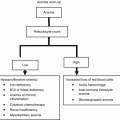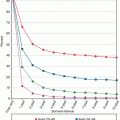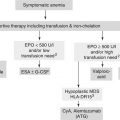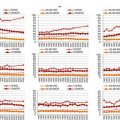© Springer-Verlag London 2015
Ulrich Wedding and Riccardo A. Audisio (eds.)Management of Hematological Cancer in Older People10.1007/978-1-4471-2837-3_1818. Patients Reported Outcome/Quality of Life
(1)
Interdisciplinary Clinical Trials Office, Comprehensive Cancer Center Mainfranken, University Hospital Würzburg, Josef-Schneider-Stzr 6, 97080 Würzburg, Germany
(2)
Department of Hematology/Oncology, University of Freiburg Medical Center, Freiburg, Germany
Abstract
Measures of patient-reported outcomes and quality of life in people with hematological malignancies resemble the subjective and thus highly personal aspects of what impacts life most when facing a malignant disease. They are of importance to both, the patients as well as their treating physicians. Despite this obvious relevance, we have a relatively poor knowledge and understanding of how these outcomes are affected in elderly patients with hematological malignancies.
We are beginning to appreciate the scope of aspects, including the presumably correct measurement of patient-reported outcomes and the various possibilities for utilization (e.g. comparing treatment effectiveness, risk factor assessment, longitudinal analyses of a treatment’s impact on functionality, quality of life, or treatment decision-making, etc.). In addition, possibilities of psycho-oncological interventions tailored to patient-reported outcomes are now increasingly utilized.
Still, there is plenty of room for meaningful contribution to the research of these matters of highest individual relevance.
Keywords
Patient-reported outcomesQuality of lifeGeriatric hematologyPrognosticationTreatment decision-makingAbbreviations
ADL
Activities of daily living
AML
Acute myeloid leukemia
CML
Chronic myeloid leukemia
HRQOL
Health related quality of life
PRO
Patient-reported outcome
QOL
Quality of life
Introduction
The easiest task to commence the chapter on Patient-Reported Outcomes (PROs) might be to give a definition: PROs describe parameters that focus on assessing health outcomes from the patient’s perspective.
To be more precise: PROs measure various aspects of a given health status and should – whenever possible – come directly from the patient. PROs may measure one specific symptom but can range to multifaceted, multidimensional outcomes. The evaluation of every subjective condition – be it purely symptomatic or complex concepts of reporting physical, mental and social well-being – is a PRO. The documentation and communication of PROs are thus the patients’ chance to be heard. Clearly, they are of highest relevance for supporting clinical decision-making. Further, they are used in clinical trials to reflect treatment effectiveness and compatibility. Regulatory agencies now support the consideration of PROs as key outcomes in cancer research.
While all the above seems obvious enough, PROs are far too often forgotten when dealing with other, seemingly more urgent concerns. Communicating PROs importance and motivating an extended use is therefore much more difficult than giving its definition.
Recently, there has been an increase in the availability of questionnaires for obtaining PROs. Scales that measure states of health and illness from the patient’s perspective obtain more and more recognition.
So far, however, psycho-social issues remain relatively unstudied in patients with hematological cancer compared with other common types of cancer. Only very few randomized controlled trials in hematology have evaluated PROs prospectively; single studies have studied them in a cross sectional fashion. Even rarer publications have dealt with PROs in the growing subset of older patients with hematological cancer. But those that did indicated, that with rising age, the PROs subjective importance even increased. It appears that in older people the topic becomes even more relevant and they seem less willing to trade off quantity of life against its quality.
High levels of patient distress have been reported for hematological cancer patients. Diagnosis and treatment can have a devastating impact on a vast number of aspects of life and the ability to fulfill roles. Major findings of PRO research in older hematological patients suggest that at diagnosis of – for example – acute leukemia in elderly patients, not only general quality of life (QOL) is compromised. Fatigue is one very prevalent condition with a devastating impact on QOL. Contrary to what one may expect, there is not necessarily a correlation between the physicians’ medical assessment of physical function and patient-reported outcomes.
Several PROs provide independent prognostic information for clinical outcomes, particularly in advanced hematologic disease settings. This field is now studied by several groups.
PRO research has the unique opportunity to push forward patient matters such as the discussions on informed consent and joint decision-making in older patients and offers enormous potential to improve the quality and results of our care.
Patient-Reported Outcomes (PROs)
Patient-reported outcomes (PROs) are one source to monitor cancer outcome. They include all parameters that are used to assess health outcomes from the patient’s point of view. They provide a means of gaining insight into the way patients perceive their health and the impact that disease-related adjustments to lifestyle or treatments have on their quality of life.
PROs provide evidence of different dimensions of health from the point of view of the patient: Be it purely symptomatic (e.g. self-reported relevance or the response of a distressing symptom), more complex (e.g. the measurement of activities of daily living) or complex (e.g. health-related quality of life). They shed light on subjective treatment impacts or effectiveness, respectively, from the patient’s perspective and are consequently of highest relevance in the discussion of diagnostic or therapeutic options with the patient.
The importance of PRO research was highlighted by the National Cancer Institute’s Strategic Objectives: To ensure the best outcome for all, improving the “quality of life for cancer patients, survivors and their families” [1]. The US Food and Drug Administration (FDA) and the European Medicines Agency (EMA) followed with their draft guidance (Feb 2006) and Reflection Paper (July 2005) in emphasizing the major importance of PROs [2, 3].
PROs assess how people feel about aspects of life that are commonly believed to be important. But as for example no clear definitions for “health status”, “quality of life”, “health-related quality of life”, and “functional status” are generally agreed upon, the optimization and development of assessing PROs are far from finished and will need significant further debate.
But for all that, the above mentioned directives are an important step towards further recognition of the relevance of the patient viewpoint, which in turn is on matters of highest subjective importance in the evaluation of a medical condition and/or therapy.
Recently, the message appears to be reaching physicians who are increasingly sensitive to the significance of psycho-social factors in the lives of their patients. More and more questionnaires that measure states of health and illness from the patient’s perspective have been developed. To date, there has been less attention paid to measures for assessing older peoples’ health in that fashion.
Despite methodological challenges and the scarcity of geriatric PRO research, there exists evidence that its assessment is feasible also in older hematological cancer patients. It has the great potential of providing valuable information and outcomes to further support/facilitate clinical decision-making. The recommendation of the most appropriate treatment for each individual patient after consideration of how alternative treatments might affect the individuals’ PROs and survival during treatment and beyond has an outstanding priority.
Quality of Life
In the following sections we will review the existing research regarding the use of PROs for older patients with hematological malignancies. The main focus lies on health-related quality of life (HRQOL). HRQOL covers almost all sub-domains of PROs, namely symptoms (disease/treatment-related), functioning (physical, role, social), well-being (psychological), as well as global health QOL perception.
We use the term “Quality of life (QOL)” in many contexts, including not only healthcare concerns but also to evaluate the general well-being of individuals and societies. As said before, there is not one accepted definition of quality of life. Still, every one of us has a personal understanding of QOL and would argue that it is extremely important. QOL for many, may stand for general life satisfaction, including health, employment, safety, communication, education, and recreational activities. For matters related to health care, the term “health-related quality of life” (HRQOL) has been agreed upon [4]. Beyond quantity of life and economic cost, HRQOL resembles one specific measure to weigh the burden of an illness or its therapy.
Although length of survival has long been considered the most important factor when evaluating treatment options, the impact of illness on quality of life has received increasing recognition. Results indicate that its relevance subjectively increases with increasing age [5].
Oncologists have used scales to quantify cancer patients’ functional capacities for treatment evaluation and planning for quite some time [6] and HRQOL assessment has been focused on for a while. The systematic assessment of HRQOL using standardized, self-administered questionnaires evolved to be one major aspect of an anticipated beneficial impact of newer therapies [7].
HRQOL is thought to be multidimensional and subjective. To measure it, we need tools that are comprehensive and are capable to meaningfully capture changes.
A definition of HRQOL is found as: “The extent to which one’s usual or expected physical, emotional and social well-being are affected by a medical condition or its treatment” [8]. HRQOL measurement thus requires the patient’s perspective and the capture of physical, emotional and social well-being [9].
We become aware of HRQOLs subjectivity when for example individual patients with the same health status report considerably diverse impairments in HRQOL. There are unique differences in expectations, internal values and coping abilities [10] and possibly many further inherent personal traits such as resilience. Obviously, HRQOL should – if at all possible – be reported by the affected individual.
With respect to HRQOL’s various dimensions, the “Patient-Reported Outcomes Measurement Information System (PROMIS) Cooperative Group” aims to create an assessment system for self–reported health. It has set up a framework of self-reported health to develop computer-based standardized questionnaires that consider the various dimensions of HRQOL [11]. Instruments are organized into subordinate domains beneath the broad physical, mental, and social health headings. Each of these components again encompasses multiple subcomponents (e.g., the mental health component is comprised of affect, behavior, and cognition). These sub-domains are then further divided (e.g., negative affect is comprised of anxiety, depression, anger, experience of stress, and the negative psychosocial impact of illness). The modules that have been developed can be accessed at the respective internet site (PROMIS, www.nihpromis.org) for research or clinical practice.
Assessing HRQOL
While survival time has been the standard indicator of treatment effectiveness, there is now a stronger recognition of the fact that time without quality is of disputable value. How to best measure HRQOL may always be a challenge and create debate.
A number of validated and reliable questionnaires for assessment of HRQOL [12] are available. They may support our notion that time added – by new therapies for example – is of adequate value to justify them. To examine the value of therapies that do not add time to life but do improve its quality is another important aspect. As Cella put it: “Only a careful evaluation of patient-reported HRQOL can allow us to evaluate the trade-offs between symptom relief and toxicity” [13].
There are different types of PROs and the same is true for HRQOL measures. But generally, they include generic health status instruments, generic illness instruments, and, the disease-specific instruments.
Generic health status instruments assess the level of functioning in various domains. They are employable in all people and populations with or without the burden of a disease. To name examples: the Nottingham Health Profile (NHP) [14] or the Short Form-36 (SF-36) [15].
To investigate the HRQOL of individuals with any medical condition, generic illness questionnaires are applied. They can be used to compare different illnesses, levels of severity, or types of interventions. In addition to measuring the general health status, these instruments typically assess the individual’s perception of the functional impact of the illness or disability. One example is the copyrighted questionnaire “Functional Assessment of Chronic Illness Therapy (FACIT)” [16]. A list of all scales that are currently part of the FACIT Measurement System is available at the respective homepage (www.facit.org/FACITOrg/Questionnaires).
Disease-specific measures investigate functioning and/or wellbeing in aspects of life that are thought to be affected in individuals with specific illnesses, specific types of treatment, or specific symptoms. They are tailored to assess in detail aspects of HRQOL in light of specific diseases and are also likely to be more sensitive to specific treatment-related changes in HRQOL.
It has become more and more common in HRQOL research, to combine generic and disease-specific instruments in order to cover all details that may impact HRQOL. One example is the European Organisation of Research and Treatment of Cancer EORTC QLQ-C30 questionnaire. It has been developed to assess the quality of life of cancer patients. It is a copyrighted instrument, which has been translated and validated into 81 languages and is used in more than 3,000 studies worldwide. Presently QLQ-C30 Version 3.0 is the most recent version (www.groups.eortc.be/qol/eortc-qlq-c30). A modular approach was adopted for disease specific treatment measurements. It is supplemented by more specific modules for e.g. Breast, Lung, Head & Neck, Oesophageal, Ovarian, Gastric, Cervical cancer, Multiple Myeloma, Oesophago-Gastric, Prostate, Colorectal Liver Metastases, Colorectal and Brain cancer which are distributed by the EORTC Quality of Life Department.
HRQOL in the Older Patient
As mentioned frequently in previous chapters, the median age at diagnosis of patients with hematological malignancies is currently around 70 years. Both the median age of patients and the proportion of elderly cancer patients are rising even further. The special aspects of an older patient’s subjective estimation of HRQOL are therefore of great importance. Notwithstanding this, older patients are under-represented in cancer trials and studies. This raises the question how – for example – comorbidities, frailty or social support impact upon treatment options as these factors significantly interact with many older patient’s HRQOL.
As Johnson et al. (2010) stated in their review, there is contradictory evidence as to whether older people with cancer have better or worse HRQOL than younger patients. Some studies reported that it is cancer rather than age that impacts upon HRQOL. Others reported that older cancer patients have similar or even better HRQOL when compared to non-cancer patients. Further aspects include the assumption that increasing age is associated with decreasing health and HRQOL and – possibly of major importance: Differing expectations on that what is individually defined “quality of life”.
The (European Organisation of Research and Treatment of Cancer) EORTC Quality of Life (QOL) Group reported in this respect that responses to their questionnaires varied with age: substantial differences were seen in responses to physical function, role function and fatigue. Owing to these facts, the EORTC QOL Group developed a questionnaire specifically for Elderly Cancer Patients (QLQ – ELD15). The module has been proposed to address potential deficiencies of the QLQ system for cancer patients who are elderly. Developmental data suggested that older patients do have different concerns and may need a specific module. The final report assessing the applicability of the QLQ-ELD15 for use in older patients with any type of cancer or hematological malignancy is expected to be completed soon [17]. The system will hopefully enable the collection of reliable, valid and clinically important information on HRQOL outcomes in older patients.
Obviously, there is no single best HRQOL questionnaire for every application nor is there agreement upon a gold standard. A scale that may be advantageous in one clinical setting is inappropriate in another. Generic and disease-specific questionnaires have advantages and disadvantages. Together, they can provide comparability across types of cancer and sensitivity to specific issues or symptoms relevant to a certain disease or treatment.
Estimating Patients’ HRQOL
Sometimes in the treatment of elderly patients it is not possible to obtain a self-reported PRO (e.g. due to cognitive impairment). In these cases, a proxy or care-giver may be asked to estimate values in HRQOL questionnaires. The few studies that have been performed investigating the reliability of results point towards an agreement between the patient’s assessment and that of the care-giver. Certainly, we need to be careful when interpreting results to take into account a number of potential biases [18]. Results on the accuracy of judgments made by the treating physicians are not so consistent.
As discussed above, the concept of quality of life includes different dimensions or aspects that play an important role in the perception individuals may have about their lives. The relative importance of each aspect is different for each person and depends on the perspective from which quality of life is considered. For example health care professionals appear to underestimate the impact of symptoms on the quality of life in some instances: In one recent study, Efficace presented to patients with chronic myeloid leukemia (CML) and to their physicians a list of 74 HRQOL relevant items and asked them to indicate the importance of each aspect on a four point scale to identify the “top ten” items concerning the HRQOL of CML patients. While both patients and physicians agreed about the relevance of fatigue, their opinions differed about the meaning of symptoms like dry mouth, trouble in concentrating/remembering things, problems of urinating frequently, drowsiness, and skin problems: patients tended to see these problems as having a greater impact on their lives [19]. This aspect is an example of the adverse impact on HRQOL of the treatment (and not solely the diagnosis) of a hematological malignancy and how the ranking in the subjective importance of these events varies. Clearly, further research will have to pick up these findings and investigate them in more detail as adverse events in hematologic therapy certainly have great importance in long-term treatments such as in CML, as symptoms may undermine the treatment commitment. While this study illustrates the challenges we have in correctly evaluating adverse events, one encouraging result of this study was that physicians appear to be increasingly sensitive among other things, to the relevance of psychosocial factors in the lives of their patients.
Stay updated, free articles. Join our Telegram channel

Full access? Get Clinical Tree







